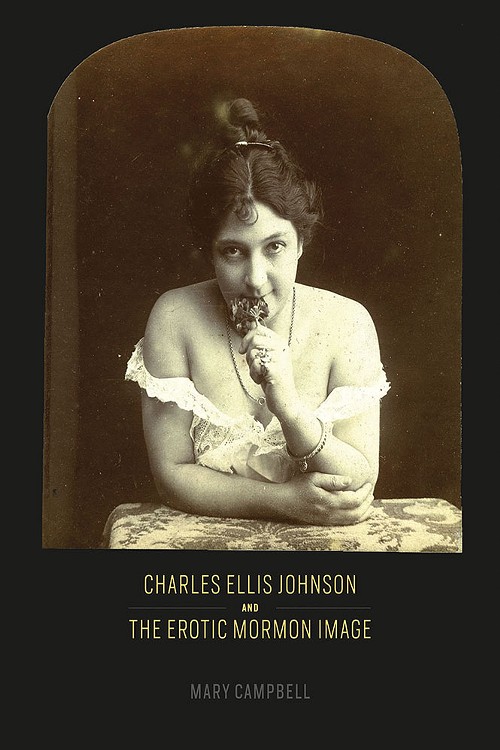Naughty and Nice
Racy photography meets the normalization of American Mormons in new book.
By Scott Renshaw @scottrenshawWhen a book comes with a title as provocative as Charles Ellis Johnson and the Erotic Mormon Image, there's bound to be some surprise when the contents are more scholarly than prurient. Its author, Mary Campbell, is well aware that it could feel like a bait-and-switch. "Am I concerned that people who buy it for the pictures are going to shell out $35 for a book that actually demands that you read the articles?" she says in an email interview. "Yeah, absolutely."
Campbell—an assistant professor of art at the University of Tennessee-Knoxville—has provided more than enough reason to read those articles. In part, her book is a profile of the title subject, a photographer who lived and worked in Utah for most of his 1857-1926 life, including production of racy postcards and "stereoscopic" images. But it's also a unique study of a time when Mormons were trying to change the American public's perception of them, at a time when polygamy had only recently been officially abandoned but that image of Mormon "harems" still held sway.
A Salt Lake City native herself with polygamous roots in her family tree, Campbell first learned about Johnson as a graduate student. "I knew that I wanted to focus my dissertation on a Mormon artist. I also knew that I wanted to write about photography," she says. As she researched possible subjects, she eventually came upon Johnson, and learned that Utah State University held some of the photographer's work in its Special Collections. When she called USU Special Collections photography curator Dan Davis, she recalls, he "promptly told me about the erotica. I remember him saying something like, 'You know that Johnson shot erotica, too. Would you like to look at that as well?'"
"To my way of thinking, there's only one answer to that question. And apparently it ends with a book."
The study of Johnson's work also interconnected with a unique facet of Campbell's background—a degree from Yale Law School on top of her art history studies. She had written a law journal article on the U.S. federal government's response to Mormon polygamy, and continued to be intrigued by an 1885 Supreme Court decision, Cannon v. United States, which ruled that cohabitation statutes applied not only to criminalizing the act of marrying multiple women, but also to "prevent a man from flaunting in the face of the world the ostentation and opportunities of a bigamous household."
"Here you see the Court effectively classifying [polygamy] as a crime of appearance as much as a crime of domestic relations or sex," Campbell says. "If a Mormon defendant looked like a polygamist ... that was sufficient evidence for a conviction, regardless of what happened to be going on in the bedroom."
Campbell digs into that focus on the image of Mormons through its connection to Johnson's photography, which also included photographs of Mormon families in a way that was careful to avoid explicitly connecting a man to multiple wives. "The Court gave Congress free rein to go to town on the Mormons because they broadcast the wrong image," Campbell says. "Is it any surprise, then, that the Mormons fought back in the realm of image? ... The polygamy scandal effectively forced Mormons to hyper-manage their public face more than a century before Instagram and Facebook would make that a daily practice for so many of us."
Of course, there are also those naughty photos that were another part of Johnson's wide-ranging business interests—and while Johnson's own photos were far less explicit than many others that were available at the time, they also connect Utah to its early integrations into a bigger world. Many of Johnson's subjects were chorus girls in traveling vaudeville shows, and Johnson himself was consistently fascinated with new technology and the most significant events to hit the state, like visits from Teddy Roosevelt or Buffalo Bill Cody.
The most eye-opening element of Campbell's book, however, might be in the double-meaning of the title. As much as it's about a photographer who took pictures of scantily-clad women in Utah circa 1900, it's about a time when—improbable as it might seem today—the rest of America associated the state with raging sexuality. "I'm enough of a word geek ... to enjoy the way that Erotic Mormon Image doesn't refer only to Johnson's work," Campbell says, "but also encompasses Gentile America's long-held view of the saints as a lascivious, polygamous menace."
And Campbell loves the way that this particular story combines her legal and artistic background in a story of Mormons trying to shift that view through photographs. "The longer you look," she says, "the more you'll see that images often present their viewers with arguments rather than straight reflections—visual arguments about how the world was, how it should be, what a particular society hoped for, feared, couldn't cop to. In this respect, images ... are like really phenomenal trial lawyers. They try to slide all sorts of arguments past you as straight fact when, in fact, they're spinning stories."
More by Scott Renshaw
-
Feature film review: THE BEAST
A filmmaker's compelling ideas get a bit tangled in references to his creative influences.
- Apr 17, 2024
-
Faces of Salt Lake County book and portrait reception
Images and personal stories in a new book reveal local demographic diversity
- Apr 17, 2024
-
Film Reviews: New Releases for April 12
Civil War, Escape from Germany, Coup de Chance, Hundreds of Beavers, La Chimera, Sting
- Apr 11, 2024
- More »
Latest in Arts & Entertainment
Readers also liked…
-
New TV for January 2023
Mayfair Witches, Velma, The Last of Us, Poker Face and more premieres
- Jan 4, 2023




